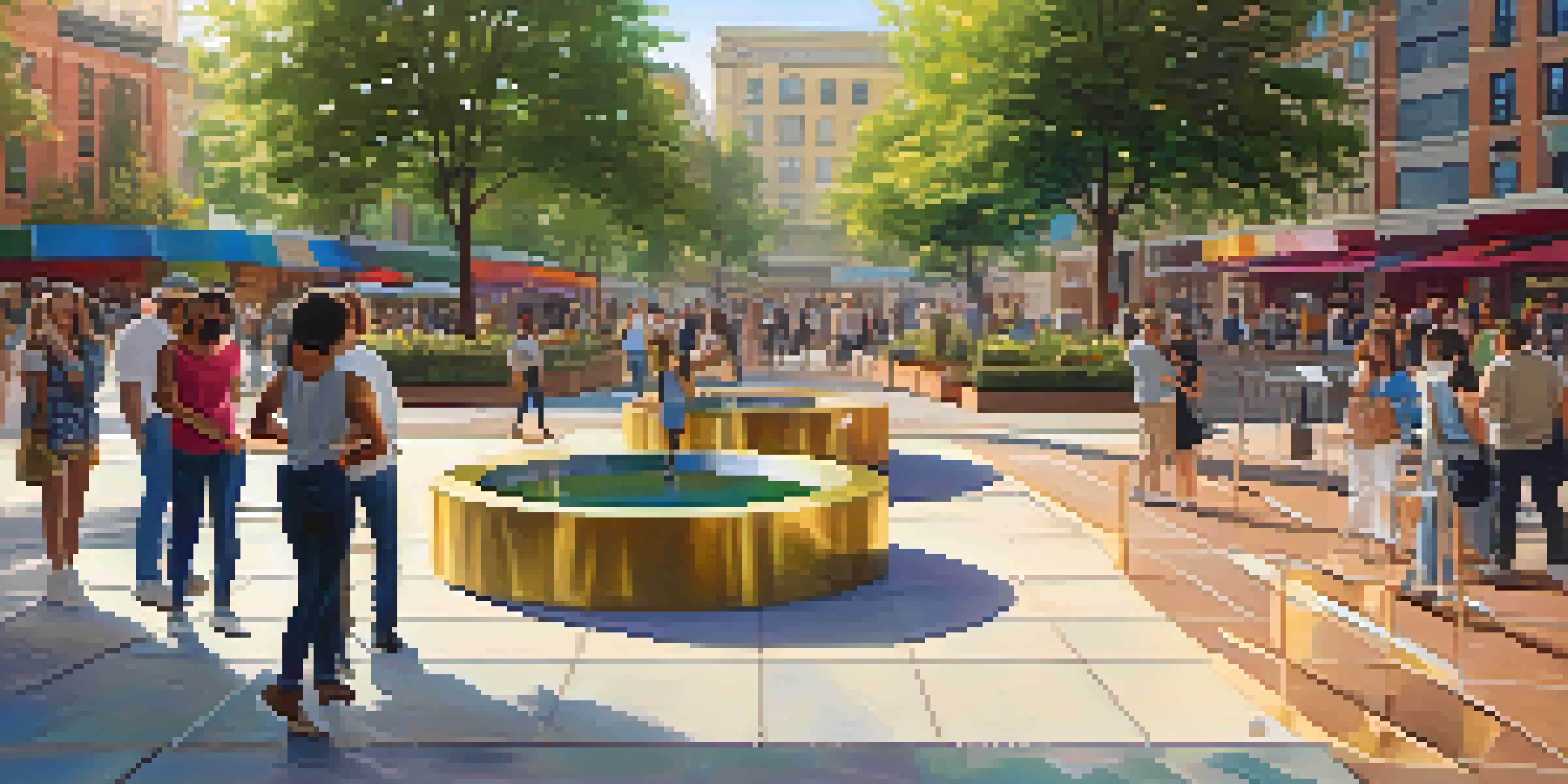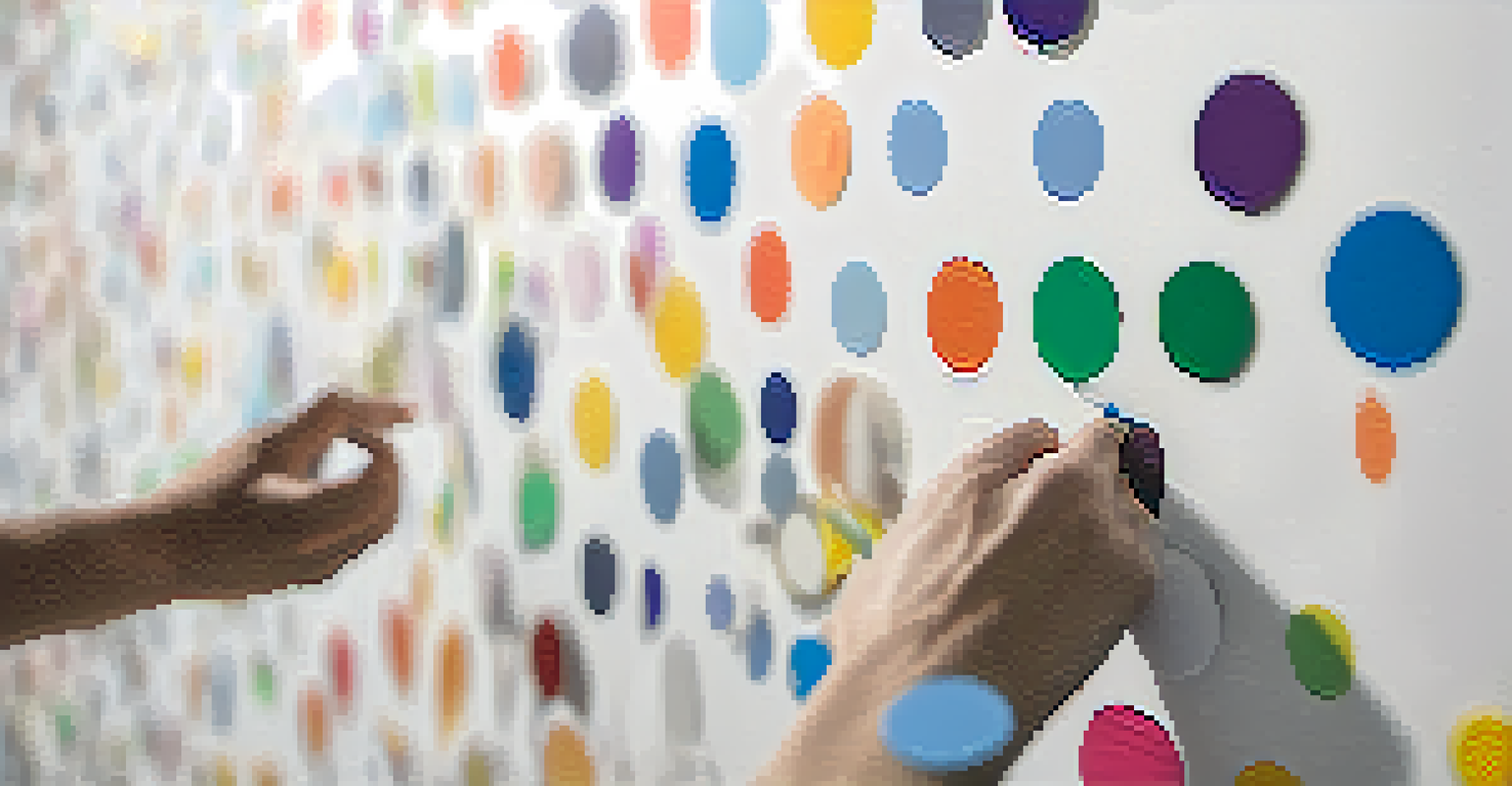Interactive Public Art: Engaging Citizens in Urban Spaces

Understanding Interactive Public Art and Its Purpose
Interactive public art refers to installations that invite participation from people, turning passive viewers into active participants. These artworks often encourage engagement through touch, movement, or social interaction, making art a living part of the community. The goal is to break down barriers between the art and the audience, fostering a shared experience that is both personal and collective.
Art is not a thing; it is a way.
Imagine walking past a mural that not only beautifies a wall but also changes colors when you touch it. This type of interaction transforms the way we experience our surroundings, making art accessible and relatable. It invites individuals to leave their mark, literally and metaphorically, creating a sense of ownership and belonging.
Moreover, interactive art can serve as a platform for dialogue, addressing social issues or celebrating community identity. By engaging citizens in this way, these installations help spark conversations that can lead to deeper connections and collaborations within urban environments.
The Role of Technology in Interactive Public Art
Technology plays a significant role in the evolution of interactive public art, enhancing the ways people engage with their environments. From augmented reality to sensors that respond to movement, tech innovations allow artists to create immersive experiences that captivate audiences. This blend of art and technology can transform a simple park into an interactive playground, where digital elements bring static installations to life.

For example, think of a public installation that uses projection mapping to create stunning visual displays based on real-time data like weather or community events. Such integrations not only entertain but also inform, making the art relevant to the audience’s daily lives. By leveraging technology, artists can craft experiences that resonate on multiple levels, drawing in diverse groups of people.
Interactive Art Engages Communities
Interactive public art transforms viewers into participants, fostering community engagement and shared experiences.
However, while technology enriches the experience, it’s essential to ensure that it remains accessible. The goal is not just to dazzle but to create art that can be enjoyed by all, regardless of tech-savviness. Balancing innovation with inclusivity is key to the success of interactive public art.
Benefits of Interactive Public Art for Communities
Interactive public art offers numerous benefits to communities, promoting social cohesion and enhancing urban environments. By encouraging participation, these artworks help build relationships among residents, fostering a sense of community pride. People often gather around these installations, sharing experiences and stories, which can lead to stronger neighborhood ties.
The role of the artist is to make the revolution irresistible.
Additionally, interactive art can revitalize underused spaces, transforming them into vibrant hubs of activity. For instance, a neglected plaza can become a lively gathering spot with the right interactive installation, attracting foot traffic and stimulating local businesses. This revitalization not only beautifies the area but also contributes to the local economy.
Moreover, these projects can spark interest in creativity and the arts among residents. When people see themselves reflected in the art around them, they may be inspired to express their creativity, leading to more community-driven art projects and initiatives.
Case Studies: Successful Interactive Public Art Projects
Examining successful case studies highlights the potential of interactive public art. One notable example is 'The Obliteration Room' by Yayoi Kusama, where visitors are invited to add colorful dot stickers to a completely white room. This collaborative effort transforms the space into a vibrant explosion of color, showcasing the power of collective creativity.
Another inspiring project is the 'Digital Water Pavilion' in Zaragoza, Spain, where a large water curtain functions as both a cooling mechanism and an interactive display. Visitors can walk through and manipulate the flowing water, creating a playful experience that draws people into the space. Such projects illustrate how art can merge functionality with aesthetic pleasure.
Technology Enhances Art Experiences
Innovative technologies, like augmented reality, play a crucial role in creating immersive and accessible public art installations.
These examples not only highlight artistic innovation but also demonstrate the profound impact of community involvement. When citizens engage with these projects, they become part of the artwork’s story, fostering a deep connection between the art, the space, and the people.
Challenges in Implementing Interactive Public Art
While interactive public art offers many advantages, several challenges can arise during implementation. One significant hurdle is securing funding and resources to bring these projects to life. Artists may need to collaborate with local governments, businesses, or nonprofits to obtain the necessary support, which can sometimes complicate the process.
Another challenge is ensuring inclusivity and accessibility for all community members. Artists must consider the diverse needs of the population, including those with disabilities, to ensure everyone can participate in the experience. This might require additional planning and resources, but it is crucial for fostering a truly inclusive environment.
Lastly, maintenance can be a concern, as interactive installations may require regular upkeep to remain functional and safe. Communities need to be proactive in planning for the long-term care of these artworks to ensure they continue to serve their purpose and engage citizens over time.
How Citizens Can Get Involved with Interactive Art
Getting involved with interactive public art is easier than you might think, and there are many ways for citizens to participate. One of the most accessible ways is to attend community events or workshops where local artists showcase their work. These gatherings often invite public input, allowing residents to share their ideas or even contribute to the projects.
Additionally, social media can be a powerful tool for engagement. By sharing experiences or promoting interactive art installations, citizens can spread the word and encourage others to join in. Many artists also use social media to gather feedback or ideas for their projects, creating an ongoing dialogue between creators and the community.
Community Involvement is Essential
Active participation from citizens is vital for the success of interactive art, strengthening neighborhood ties and encouraging creativity.
Volunteering for art installations is another fantastic way to get involved. Many projects seek community members to help with setup, maintenance, or even participation in the artwork itself. This hands-on involvement not only enhances the art experience but also strengthens community bonds.
The Future of Interactive Public Art in Urban Spaces
As urban areas continue to evolve, the future of interactive public art looks promising. Cities are increasingly recognizing the value of integrating art into public spaces, viewing it as a means to enhance livability and community engagement. This shift suggests a growing trend towards innovative projects that prioritize citizen participation.
Moreover, advancements in technology will likely play a pivotal role in shaping the next generation of interactive art. As new tools and platforms emerge, artists will have more opportunities to create dynamic experiences that respond to the needs and desires of their communities. Imagine an urban landscape where every street corner offers a unique interactive experience tailored to the residents’ interests.

Ultimately, the continued success of interactive public art will depend on collaboration among artists, urban planners, and community members. By working together, these stakeholders can ensure that future projects not only enrich urban spaces but also foster a deeper sense of connection and belonging among citizens.